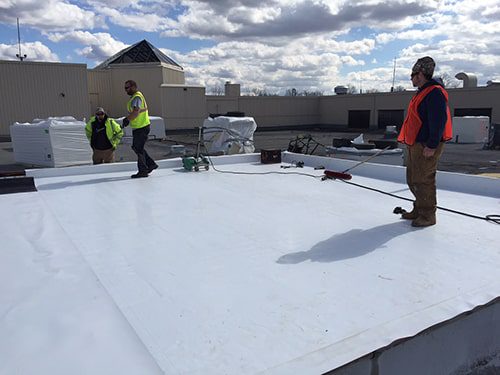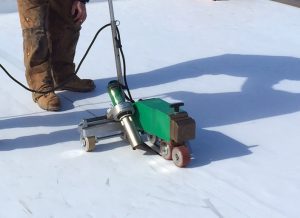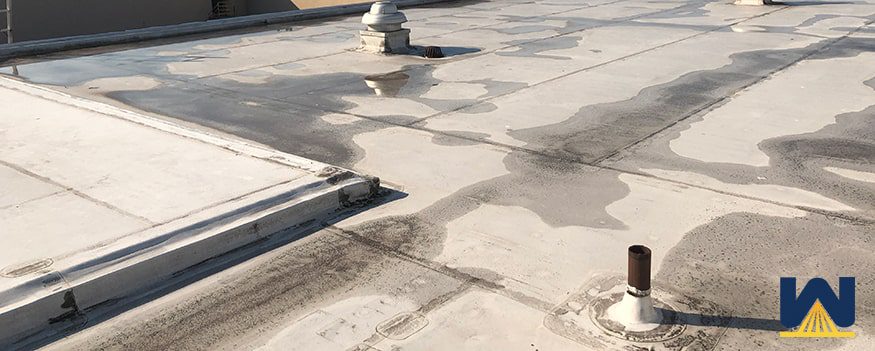So, you’re thinking about TPO roofing and you wonder, what happens if there’s a tear in this thing?
It’s a big concern.
Roofing systems cost a lot of money to install, and it would be devastating to have any issues.
The short answer is if you have a tear in a TPO roof, the wind will expand the tear, exposing more of the roof’s insulation.
This is a problem because the insulation that’s under the TPO membrane is not waterproof. Water will get into the insulation and spread horizontally (saturating more of the roof’s insulation) and vertically (until it reaches the roof deck).
You may have some questions, such as:
- Do I currently have a TPO roof?
- How can a tear happen? What is a real-life scenario?
- How can a small tear end up costing me big money?
- What should I do to prevent this from happening?
- Are there other roof systems that will not tear?
We’ll answer all these questions below.
And just so you know that we write articles from true events and experience, every piece of content written at West Roofing Systems is produced in-house. Every article is reviewed and edited by a roofer/salesman with more than 30+ years of experience in the field.
Let’s get started!
What is a TPO roof?
TPO stands for Thermoplastic Polyolefin. TPO is one of many single-ply roofing systems that are installed on commercial buildings.

A key characteristic of TPO roofs is that the sheets and accessories are heat-welded together.

TPO roofs are usually white (to maximize sun reflectivity) but we’ve seen them in other colors as well.
Now that you know what a TPO roof is, let’s get into how they can tear.
How can a tear happen on a TPO roof?
Here are a few ways this can happen:
- Flying debris in storms
- Animals
- UV rays can cause cracks
- Someone drops a sharp object or tool
- Hail damage
What is a real-life example?
A common real-life example is flying debris during storms. We’ve seen storms that have flown sharp branches, 2×4’s, etc. These can puncture and tear TPO roofs.
Once the tear happens and the roof’s insulation is exposed, that’s when costly repairs begin if the tear isn’t found promptly.
How can a small tear end up costing a lot of money?
If you have a small tear and it’s repaired quickly, then the tear will not cause a significant amount of money.
The problem is that tears usually go unnoticed, and they are unintentionally ignored. And when no one goes on the roof for 3 months, 6 months, or even longer, rain is continually getting into the insulation.
How can ignoring a tear cost a lot of money?
The roof’s insulation is not waterproof. Meaning that even if you have a small tear in your TPO roof, that water will get into the insulation and spread.
Over time, water will reach a large portion of your insulation.
It’s similar to how water spreads on a paper towel. The water can enter through a corner of the paper, and with enough water, it will spread and soak the entire paper towel.
If more than 25% of the roof’s insulation is saturated with water, it might be in your best interest to perform a complete tear-off.
If you’re unaware of how much a new TPO roof would cost, it’ll likely be $5-$10 per square foot.
What should a building owner do to prevent a costly roof repair from happening?
This one is simple. You need to have someone look at the roof at least twice per year…and after every bad storm.
Roofing contractors know what to look for and it may be difficult to find a tear in a TPO roof.
Most roofing contractors offer roof maintenance packages between $0.03 to $0.05 per square foot.
Are there roof systems that will not tear?
Yes.
Built-up roofs will not tear.
Silicone roof coatings will not tear.
Spray-on roofing systems will not tear.
Metal roofing systems will not tear.
NOTE: A key difference in spray-on roofing systems is that the membrane and insulation are one thing. And that insulation is what’s called closed-cell. Closed-cell insulation, when it cracks or gets a hole, will not let water travel. This is a huge benefit because one incision cannot damage a large area of the roof system.
What are your next steps?
Your next steps are just to be aware of what can happen if your TPO roof gets a tear. Be aware that getting a tear isn’t preventable, but minimizing the damage is.
One scenario we commonly see at West Roofing System is that a building owner has a TPO roof that’s leaking, and they are wondering what repair options they have.
The TPO roof may be in decent shape but a few tears have allowed water to enter and spread over a large portion of the roof’s insulation.
If that area is more than 25%, in most cases we recommend a complete tear-off. It’s just not worth it to remove and replace half the TPO and half of the insulation.
Some TPO roofs have a maintenance plan which allows issues to be detected early. Most of the time, these roofs can be restored using silicone coating for much less than a complete tear-off.


